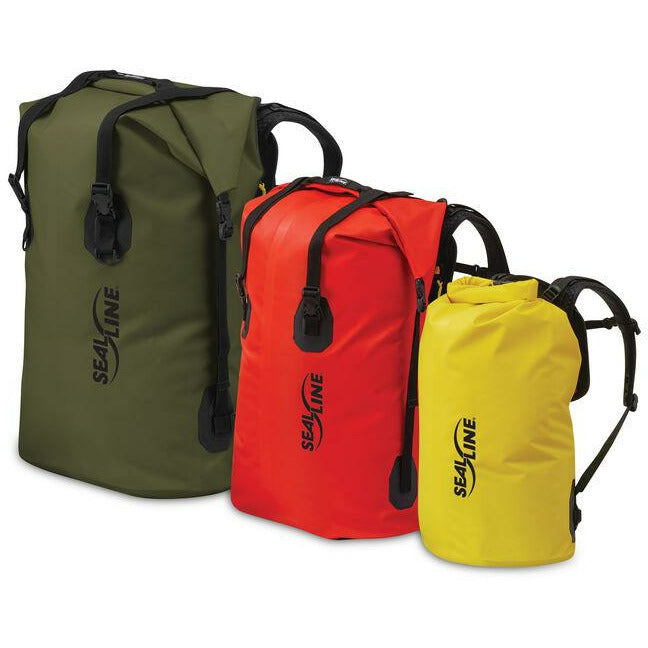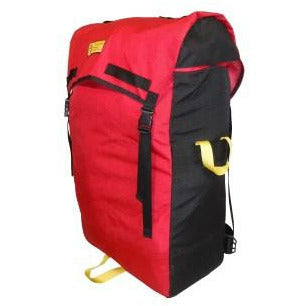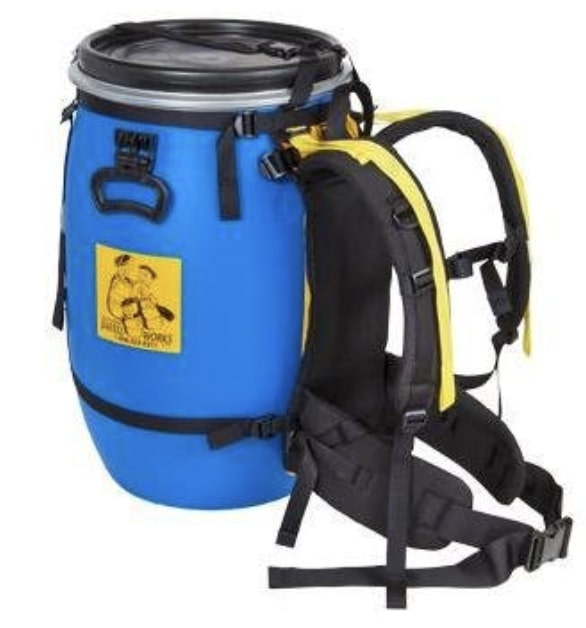It’s no surprise that canoe tripping requires a fair bit of gear and that canoe trippers love talking about their gear. However, less attention gets paid to the equipment we pack our gear into. Well, not today because in this post we’re diving into everything you need to know about canoe packs.
We’ll talk about the different types of packs, including canvas and nylon canoe packs, dry sacks and barrels. We’ll discuss which pack works best for personal gear, food and equipment and provide our top gear recommendations.
- Types of Canoe Packs
- Uses for a Canoe Pack
- What to Look for in a Canoe Pack
- Our Tops Picks for Canoe Packs
- FAQs
Types of Canoe Packs
Canvas and Nylon Canoe Packs
Canvas is one of the original materials for canoe packs. Canvas is extremely durable and weather-resistant. In addition to canvas, you can also find the same style of canoe pack made from nylon. Nylon packs tend to be lighter than canvas packs of a similar size and are less expensive.
Both canvas and nylon are water-resistant and dry reasonably quickly, however, they are not waterproof unless you use it in conjunction with a pack liner. This means you shouldn’t pack food or personal items directly in these canoe packs. Instead, use them for everything that doesn’t need to stay dry, like a campfire grill, rope, tarp, pots and pans. Or use your canoe pack to carry multiple dry sacks (more on that below).
Dry Sacks
Dry sacks are made of durable nylon and designed to be 100% waterproof when closed correctly. Most dry sacks have a roll-top which is secured with buckles. Dry sacks typically range from 5L to 120L in size.
The 5-10L sizes are good for storing personal items in the canoe with you. We like to keep our phone/camera, sunscreen, notebook and a fire kit in a small dry sack so we can easily access them throughout the day.
20-35L dry sacks are great for personal gear like clothing and sleeping bags. However, these packs usually don’t have backpack straps (though there are exceptions). You can pack multiple mid-sized dry sacks inside a canvas canoe pack, allowing you to carry multiple packs at a time and use dry sacks that don’t have backpack straps.
65L and larger are typically used for personal gear, shelter and some equipment. Dry sacks of these sizes always have backpack straps for easier portaging.
Canoe Barrels
When we’re talking about canoe packs, we usually aren’t talking about canoe barrels. However, canoe barrels fill a very important role in packing your canoeing gear.
Canoe barrels are excellent for storing food. If closed correctly, canoe barrels are airtight and almost smell proof. And if the critters do smell your food somehow, pesky rodents cannot chew through a barrel. In most circumstances, bears do not open food barrels either (though there have been cases of bears chewing through barrels in Algonquin, so you still need to properly store food and keep your campsite clean!).
You might also consider a canoe barrel for personal gear if you’ll be paddling whitewater. Barrels are very durable when thrown down rapids (just ensure you have the lid securely locked) and they float.
Uses for a Canoe Pack
Personal Gear
Your personal gear includes items like your sleeping bag and sleeping pad, your clothing, toiletries and items for entertainment. In most cases, each person on the canoe trip has their own personal pack. If you’re trying to pack light and share a personal pack, consider using packing cubes or tiny dry sacks to help organize your gear inside. On the larger trips we guide, participants place their clothes into a sleeping bag, and we stuff them directly in a dry pack. This keeps everything organized and makes for easy sleeping area setup.
Large dry sacks are excellent for personal gear. Consider a dry sack with shoulder straps on it so you can carry it like a backpack, like the SealLine Boundary Pack. Small dry sacks are perfect for the items you want in the canoe with you.
Some people (myself included) prefer to use a 60L canoe barrel for personal gear because of how secure and durable they are. Plus, the open top makes it easy to find items inside the barrel.
Equipment
Equipment usually refers to all of the gear that is used for communal activities. This likely includes cooking gear (pots, pans, utensils, grill, stoves, oven, water filter), shelter (tents and tarps) and miscellaneous items like garbage bags, dish kits and rope.
Canvas / nylon canoe packs are often used for equipment (and, as such, are often referred to as ‘equipment packs’). Most of the equipment items don’t need to be kept dry, so it isn’t necessary to put them in a waterproof pack like a barrel or dry sack. Canvas or nylon packs tend to have more flexibility and give to them, allowing you to more easily pack awkward items like pots and grills.
The Recreational Barrel Works Canoe Tripper Pack is a popular choice for a canvas / nylon canoe pack.
Food
You want to carry all of your food in something that is airtight to ensure it is waterproof and ideally smell-proof (to keep critters away). Canoe barrels are the most popular choice for carrying food. In fact, many canoeists refer to them as ‘food barrels’ because they are so often filled with food. The most popular barrel is the Recreational Barrel Works 60L Barrel.
It’s important to note that food barrels are not bear-proof. While barrels do a good job of minimizing the food smell and are better than other packs, they aren’t perfect. And barrels may be durable enough to withstand the wrath of a raccoon or squirrel, however, a bear can bite through a barrel if determined. That’s why it’s so important to keep your site food-free and store your food properly overnight.
How to store your food properly is an entirely different topic that we’l likely cover in another post. However, there are two or three main schools of thought. Those that choose to hang their barrels in a tree, those that keep them on the ground dragged far enough away from the campsite, and even those who use the “bear canoe” method where you place your barrel in a canoe, and push it out on the lake (with a long line tied to shore of course).
What to Look For in a Canoe Pack
Size
You want your canoe packs to fit all of your gear (preferably without the need to play canoe pack Tetris every morning). However, you don’t want to have packs that are so big they cannot be worn comfortably or fit inside a canoe nicely.
Canvas canoe packs are typically 75-100 L. Canoe barrels come in three sizes: 20L and 30L (great for food on a short trip or a first aid kit on a long trip) and 60L (great for food and personal gear on long trips). Dry sacks range from 5L to 120L. While it may be tempting to get a 120L dry sack (room for so much gear!) keep in mind how heavy that much gear will be.
Durability
Your canoe pack needs to be durable. The straps will get pulled when you try to force it out of the canoe; the body will get scrapped if the pack slides down rocks at a steep put-in. It’s important to be gentle with your gear, but also recognize that the wilderness is a rough place.
Body Material
Think about the material being used. Waxed canvas is a popular choice for canoe packs. For more durability, you want a heavier, thicker canvas. Many of the popular brands use a waxed canvas with a weight of around 18 oz, and this is sufficient for canoe tripping.
For dry sacks, two popular materials are polyurethane-coated polyester and nylon. Both of these are extremely durable and resistant to scrapes and abrasions.
Straps and Connection Points
The second place you’ll want to consider for durability is at the connection points between the body and the straps. When canoe packs break, most often it is at one of these connection points. How is the strap secured to the pack? Does it feel sturdy?
This will come down to the quality of the construction of the pack (and the care you take when handling the pack). Read reviews on canoe packs and avoid any that have multiple reviews about straps breaking.
Carrying Comfort
Carrying comfort is an underrated consideration when choosing a canoe pack. If you’ve ever carried a huge, lopsided pack on a long portage… you’ll know what we mean.
Canvas canoe packs can be difficult for beginners to carry. Their free-form material shape makes it easy to pack awkward-shaped equipment, like pots and fuel. But this means you have to be careful not to end up with all of the heavy objects on one side or something sharp poking out in the center of your back.
Dry sacks are fairly comfortable to carry as well, so long as they aren’t too heavy.
Canoe barrels also tend to be uncomfortable, especially when they are fully loaded. It doesn’t help that, by design, a barrel is round while your back is flat. However, you can mitigate this by choosing a barrel harness that is secure, padded and fits well for your specific body. Also, the person who carrier the barrel on the first day (when it’s heaviest) also carries it on the last day (when it’s lightest).
It may take some experimentation (and trying out your friends’ gear on future portages) to learn what kind of packs work best for your body.
Waterproofness
The degree of waterproof protection you need will depend on the type of trip you’re doing and how risk-averse you are.
Many people choose to pack their gear in 100% waterproof bags. This means their gear will stay dry in a pouring thunderstorm or in the event of a canoe tipping over. We recommend always placing safety gear (like the first aid kit and sat phone) and personal gear (like sleeping bags) in 100% waterproof packs, like a dry sack or a canoe barrel.
Some people will choose packs that are waterproof enough to stay dry in the rain but aren’t waterproof if placed underwater. Equipment that doesn’t need to stay dry (i.e. pots and pans, grills) is often placed in packs like this, usually in a canvas canoe pack. Additionally, some people will keep all of their personal gear in small, lightweight dry sacks and keep those in a backpack that isn’t waterproof.

Our Tops Picks for Canoe Packs
Below we’ve highlighted a few canoe packs that we’re especially fond of.

The SealLine Boundary series is one of the most popular dry sacks on the market. It offers a simple but effective design and – if closed correctly – is waterproof even in immersion. It’s available in three sizes: 35L, 65L and 115L.
Each of the sizes has a backpack harness, making them easy to portage. The harness is actually removable for added versatility.

The SealLine PRO Pack 120L is an excellent choice for a personal pack for long canoe trips. With a pack so large, it’s easy to fit all of your clothing, sleeping gear, personal items and even your tent in the same pack. The straps are comfortable for portaging and the welded seams ensure durability and waterproofness.

Canvas Canoe Pack
The Recreational Barrel Works Expedition Canoe Pack is a rugged canoe pack that will last years to come. Its simple design is easy to pack and perfect for loading kitchen gear and other equipment. The pack has adjustable shoulder and hip straps for easy portaging.
Although this canoe pack isn’t waterproof, the canvas material dries very quickly (use a pack liner for ultimate waterproofness). If you get caught in a storm or drop your pack in the lake, your pots and pans may get wet, but you won’t be carrying around a soggy pack for the rest of your trip!
Side note, the OG pack maker, Bill Ostrom, and his company Ostrom Outdoors also makes some of the finest packs around. Unfortunately we don’t carry them but make sure to check them out as well and tell Bill that Trip Shed sent you!

Canoe Barrel
The Recreational Barrel Works Canoe Barrel is the most popular maker for canoe barrels. The 60L is the standard size, though it is also available in 20L and 30L.
The barrel itself is made from durable plastic with two external handles. The lid contains an O-ring, ensuring waterproofness when secured by the metal ring.

Canoe Barrel Harness
Barrels are awkward to carry on portages. To make them easier to carry, choose a comfortable barrel harness with adjustable hip, shoulder and sternum straps.
We love the North Water Quick Haul Harness as it has adjustable straps and securely attaches to the barrel (so you won’t feel it moving around while you portage). The back panel and shoulder straps are padded, to make portaging even more comfortable.
FAQs about Canoe Packs
What about the wannigan?
The wannigan had long been a staple in canoe packing. A wannigan is a large wooden box with a lid and a long strap called a tump line. To carry it on portages, the wannigan rests on your lower back with the tump resting on your forehead. It definitely takes some practice to get used to carrying it, but if you can manage it, wannigans are great for storing kitchen equipment (plus the lid is great for a kitchen counter!).
Within the last decade or so, wannigans have lost a lot of their popularity but are still used my many traditionalists. Most people opt for a combination of packs, dry sacks and barrels instead.
Can you use a backpack for canoe trips?
Yes, you can. Hiking backpacks are very comfortable to wear on long portages (they’re made for carrying, after all!). However, backpacks are not waterproof so you’ll want all of your gear to be inside small, lightweight dry sacks inside. Additionally, it’s difficult to pack large and awkward gear (pots, grills, Dutch oven) into a backpack. The main reason however, that we usually don’t use a traditional hiking pack on trips is its size in relation to the canoe. For one, canoe packs typically fit better in the canoe while paddling based on its shorter length. Additionally, hiking packs are designed to be slimmer, sit closer to the body, and as a result are taller. This ends up pushing on the inside of the canoe while you’re portaging it and can make for a bit of an awkward ride. That said, the best pack is the one you’ve got – just get out there and use it.
How do I close my dry sack to ensure it stays dry?
Most dry sacks have a roll-top with two buckles. The rolls are what keep your bag waterproof and the buckles keep the rolls secure. The biggest mistake we see with new campers and their dry sacks is not rolling the top correctly. Watch this video for a demonstration.
In Conclusion
We hope this post has helped you determine which canoe packs you need for your upcoming canoe trips. You can view all of our canoe packs here. If you have any questions, please get in touch with us and we’ll find the right pack for you!




